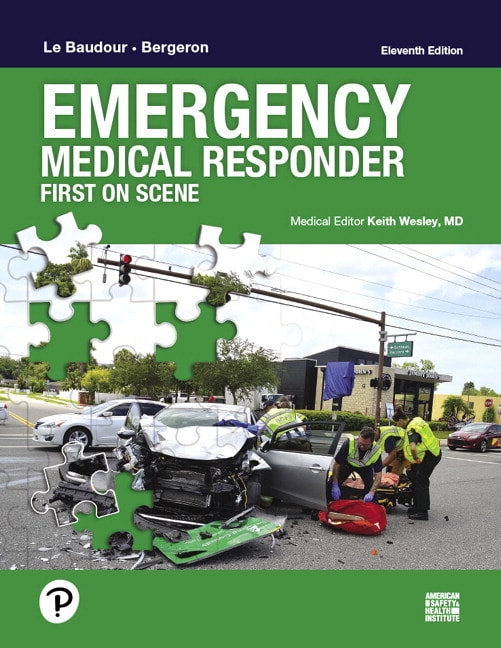
Emergency Medical Responder: First on Scene, 11th edition
- Chris Le Baudour
- , J David Bergeron
- , Keith Wesley

- Study simpler and faster
Use flashcards and other study tools in your eTextbook
- Listen on the go
Learn how you like with full eTextbook audio
- Find it fast
Quickly navigate your eTextbook with search
- Stay organized
Access all your eTextbooks in one place
- Easily continue access
Keep learning with auto-renew
Emergency Medical Responder is the leader in the field. It provides clear, first responder-level training for fire service, emergency, law enforcement, military, civil and industrial personnel. The text is based on the new National Emergency Medical Services Education Standards for Emergency Medical Responders. It also includes the 2017 Focused Updates from the American Heart Association Guidelines for Cardiopulmonary Resuscitation and First Aid.
The 11th Edition has been fully updated for consistency with the latest industry standards. It also covers new topics recently introduced into emergency medical responder programs. Step-by-step skills, presented in 90 photo scans, give you a quick reference resource. At the end of each chapter, you'll complete critical-thinking questions prompting you to consider how you might respond to a First on Scene scenario.
Published by Pearson (September 18th 2020) - Copyright © 2019
ISBN-13: 9780136873143
Subject: Emergency Services (BRADY)
Category: Emergency Medical Responder
- Introduction to EMS Systems
- Legal and Ethical Principles of Emergency Care
- Wellness and Safety of the Emergency Medical Responder
- Introduction to Medical Terminology, Human Anatomy, and Lifespan Development
- Introduction to Pathophysiology
- Principles of Lifting, Moving, and Positioning of Patients
- Principles of Effective Communication
- Principles of Effective Documentation
- Principles of Airway Management and Ventilation
- Principles of Oxygen Therapy
- Principles of Resuscitation
- Obtaining a Medical History and Vital Signs
- Principles of Patient Assessment
- Caring for Cardiac Emergencies
- Caring for Respiratory Emergencies
- Caring for Common Medical Emergencies
- Caring for Environmental Emergencies
- Caring for Soft-Tissue Injuries and Bleeding
- Recognition and Care of Shock
- Caring for Muscle and Bone Injuries
- Caring for Head and Spinal Injuries
- Caring for Chest and Abdominal Emergencies
- Care During Pregnancy and Childbirth
- Caring for Infants and Children
- Special Considerations for the Geriatric Patient
- Introduction to EMS Operations and Hazardous Response
- Introduction to Multiple-Casualty Incidents, the Incident Command System, and Triage
Appendices
- Patient Monitoring Devices
- Principles of Pharmacology
- Air Medical Transport Operations
- Introduction to Terrorism Response and Weapons of Mass Destruction